Evaluating Major Projects: EIA, Risk & Life Cycle Analysis in SA
VerifiedAdded on 2023/06/04
|14
|3233
|245
Essay
AI Summary
This essay provides a comprehensive evaluation of the Environmental Impact Assessment (EIA) process within the context of major projects, focusing particularly on the South Australian system. It begins by defining environmental assessment and its role in project planning, emphasizing the importance of integrating environmental considerations with economic and social factors. The essay critically examines the EIA system, highlighting its benefits such as reducing project costs and increasing community acceptance, as well as its principles and purposes, including facilitating decision-making and promoting sustainable development. It details the steps in the EIA process, from project screening and scoping to post-decision monitoring, and also discusses the application of risk and life cycle analysis in evaluating major project proposals. The essay further touches upon the legislative requirements for environmental protection and the role of government agencies in ensuring environmental safeguards are in place. This document is available on Desklib, a platform offering a wide array of study tools and solved assignments for students.
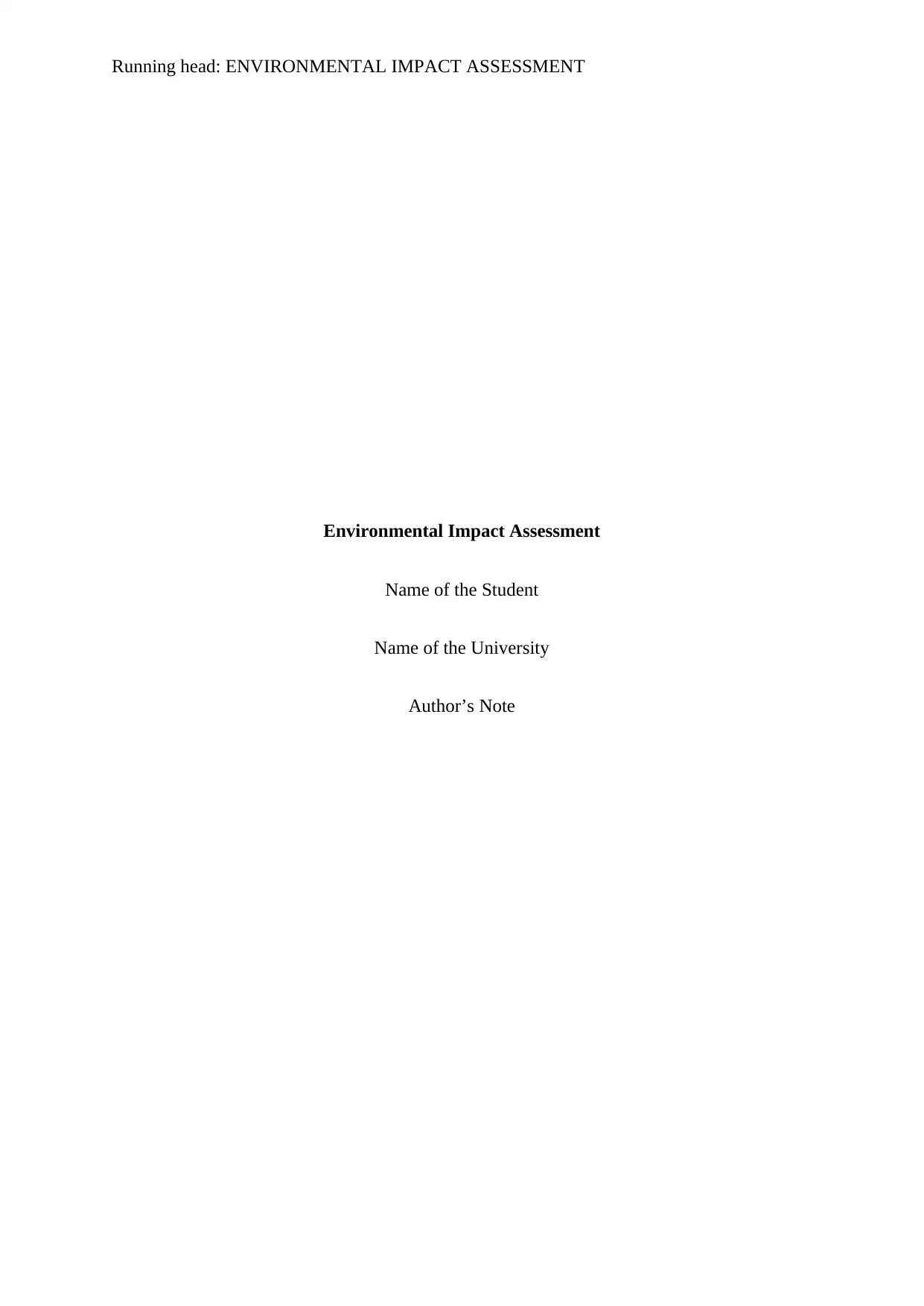
Running head: ENVIRONMENTAL IMPACT ASSESSMENT
Environmental Impact Assessment
Name of the Student
Name of the University
Author’s Note
Environmental Impact Assessment
Name of the Student
Name of the University
Author’s Note
Paraphrase This Document
Need a fresh take? Get an instant paraphrase of this document with our AI Paraphraser
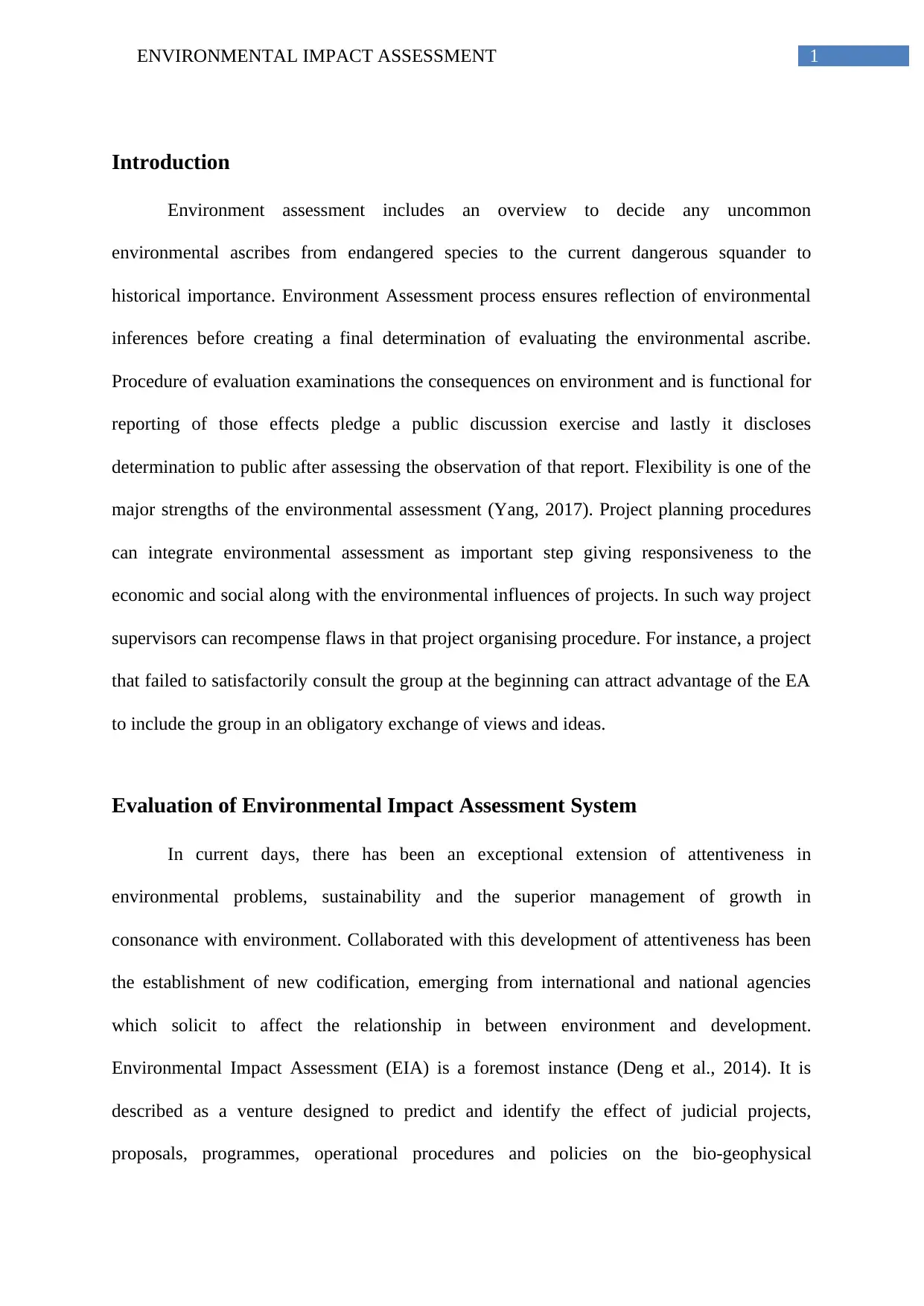
1ENVIRONMENTAL IMPACT ASSESSMENT
Introduction
Environment assessment includes an overview to decide any uncommon
environmental ascribes from endangered species to the current dangerous squander to
historical importance. Environment Assessment process ensures reflection of environmental
inferences before creating a final determination of evaluating the environmental ascribe.
Procedure of evaluation examinations the consequences on environment and is functional for
reporting of those effects pledge a public discussion exercise and lastly it discloses
determination to public after assessing the observation of that report. Flexibility is one of the
major strengths of the environmental assessment (Yang, 2017). Project planning procedures
can integrate environmental assessment as important step giving responsiveness to the
economic and social along with the environmental influences of projects. In such way project
supervisors can recompense flaws in that project organising procedure. For instance, a project
that failed to satisfactorily consult the group at the beginning can attract advantage of the EA
to include the group in an obligatory exchange of views and ideas.
Evaluation of Environmental Impact Assessment System
In current days, there has been an exceptional extension of attentiveness in
environmental problems, sustainability and the superior management of growth in
consonance with environment. Collaborated with this development of attentiveness has been
the establishment of new codification, emerging from international and national agencies
which solicit to affect the relationship in between environment and development.
Environmental Impact Assessment (EIA) is a foremost instance (Deng et al., 2014). It is
described as a venture designed to predict and identify the effect of judicial projects,
proposals, programmes, operational procedures and policies on the bio-geophysical
Introduction
Environment assessment includes an overview to decide any uncommon
environmental ascribes from endangered species to the current dangerous squander to
historical importance. Environment Assessment process ensures reflection of environmental
inferences before creating a final determination of evaluating the environmental ascribe.
Procedure of evaluation examinations the consequences on environment and is functional for
reporting of those effects pledge a public discussion exercise and lastly it discloses
determination to public after assessing the observation of that report. Flexibility is one of the
major strengths of the environmental assessment (Yang, 2017). Project planning procedures
can integrate environmental assessment as important step giving responsiveness to the
economic and social along with the environmental influences of projects. In such way project
supervisors can recompense flaws in that project organising procedure. For instance, a project
that failed to satisfactorily consult the group at the beginning can attract advantage of the EA
to include the group in an obligatory exchange of views and ideas.
Evaluation of Environmental Impact Assessment System
In current days, there has been an exceptional extension of attentiveness in
environmental problems, sustainability and the superior management of growth in
consonance with environment. Collaborated with this development of attentiveness has been
the establishment of new codification, emerging from international and national agencies
which solicit to affect the relationship in between environment and development.
Environmental Impact Assessment (EIA) is a foremost instance (Deng et al., 2014). It is
described as a venture designed to predict and identify the effect of judicial projects,
proposals, programmes, operational procedures and policies on the bio-geophysical
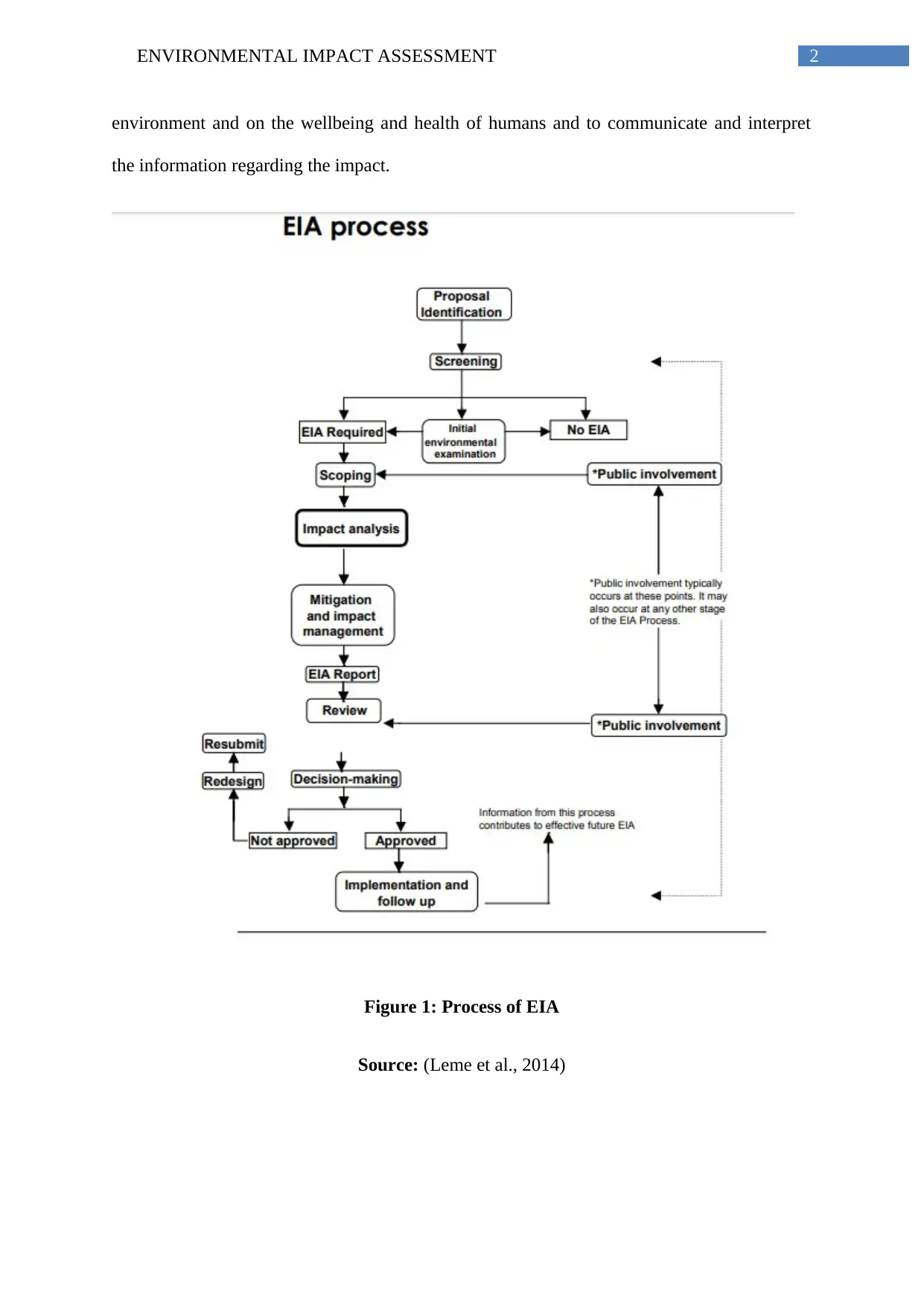
2ENVIRONMENTAL IMPACT ASSESSMENT
environment and on the wellbeing and health of humans and to communicate and interpret
the information regarding the impact.
Figure 1: Process of EIA
Source: (Leme et al., 2014)
environment and on the wellbeing and health of humans and to communicate and interpret
the information regarding the impact.
Figure 1: Process of EIA
Source: (Leme et al., 2014)
⊘ This is a preview!⊘
Do you want full access?
Subscribe today to unlock all pages.

Trusted by 1+ million students worldwide
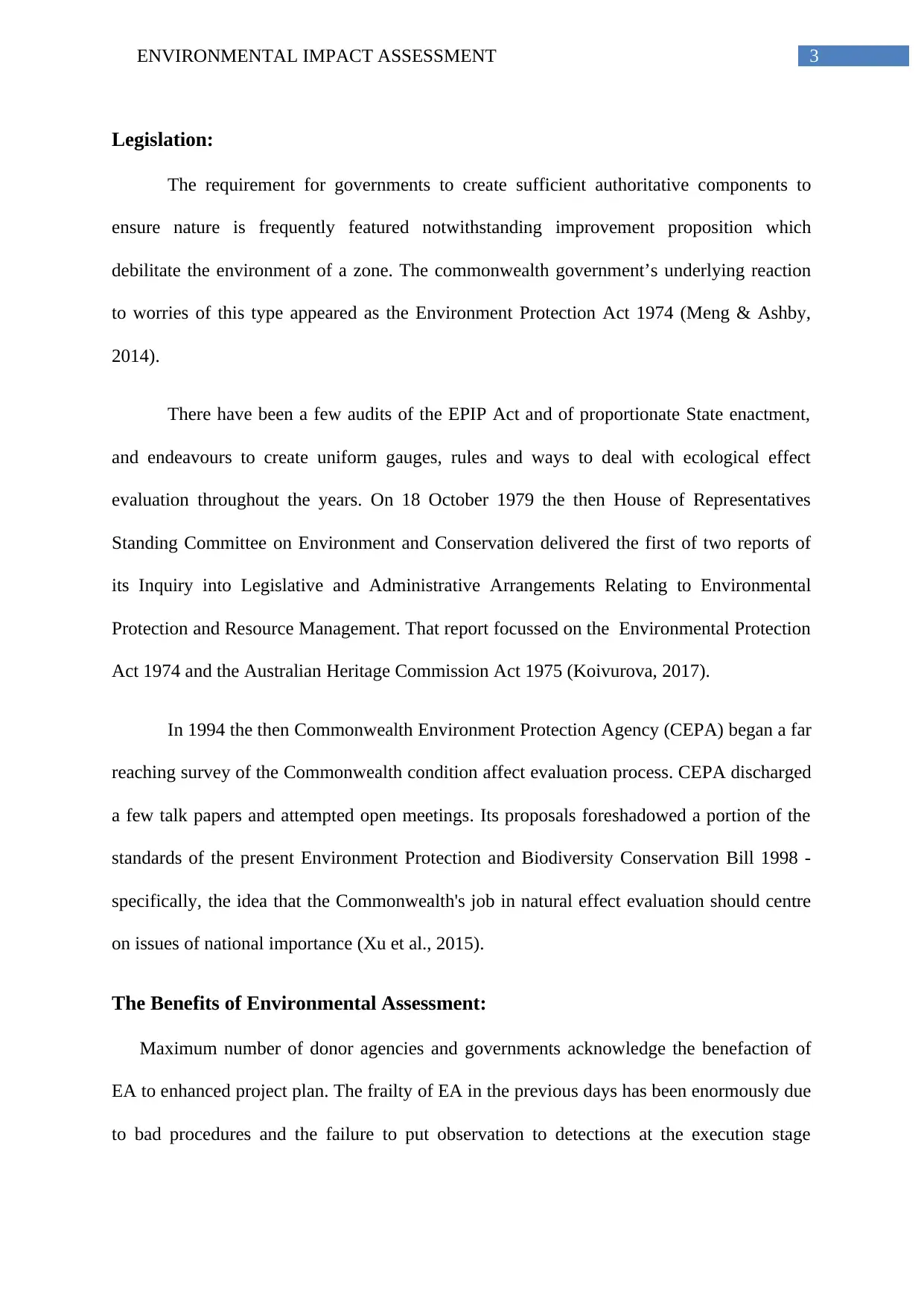
3ENVIRONMENTAL IMPACT ASSESSMENT
Legislation:
The requirement for governments to create sufficient authoritative components to
ensure nature is frequently featured notwithstanding improvement proposition which
debilitate the environment of a zone. The commonwealth government’s underlying reaction
to worries of this type appeared as the Environment Protection Act 1974 (Meng & Ashby,
2014).
There have been a few audits of the EPIP Act and of proportionate State enactment,
and endeavours to create uniform gauges, rules and ways to deal with ecological effect
evaluation throughout the years. On 18 October 1979 the then House of Representatives
Standing Committee on Environment and Conservation delivered the first of two reports of
its Inquiry into Legislative and Administrative Arrangements Relating to Environmental
Protection and Resource Management. That report focussed on the Environmental Protection
Act 1974 and the Australian Heritage Commission Act 1975 (Koivurova, 2017).
In 1994 the then Commonwealth Environment Protection Agency (CEPA) began a far
reaching survey of the Commonwealth condition affect evaluation process. CEPA discharged
a few talk papers and attempted open meetings. Its proposals foreshadowed a portion of the
standards of the present Environment Protection and Biodiversity Conservation Bill 1998 -
specifically, the idea that the Commonwealth's job in natural effect evaluation should centre
on issues of national importance (Xu et al., 2015).
The Benefits of Environmental Assessment:
Maximum number of donor agencies and governments acknowledge the benefaction of
EA to enhanced project plan. The frailty of EA in the previous days has been enormously due
to bad procedures and the failure to put observation to detections at the execution stage
Legislation:
The requirement for governments to create sufficient authoritative components to
ensure nature is frequently featured notwithstanding improvement proposition which
debilitate the environment of a zone. The commonwealth government’s underlying reaction
to worries of this type appeared as the Environment Protection Act 1974 (Meng & Ashby,
2014).
There have been a few audits of the EPIP Act and of proportionate State enactment,
and endeavours to create uniform gauges, rules and ways to deal with ecological effect
evaluation throughout the years. On 18 October 1979 the then House of Representatives
Standing Committee on Environment and Conservation delivered the first of two reports of
its Inquiry into Legislative and Administrative Arrangements Relating to Environmental
Protection and Resource Management. That report focussed on the Environmental Protection
Act 1974 and the Australian Heritage Commission Act 1975 (Koivurova, 2017).
In 1994 the then Commonwealth Environment Protection Agency (CEPA) began a far
reaching survey of the Commonwealth condition affect evaluation process. CEPA discharged
a few talk papers and attempted open meetings. Its proposals foreshadowed a portion of the
standards of the present Environment Protection and Biodiversity Conservation Bill 1998 -
specifically, the idea that the Commonwealth's job in natural effect evaluation should centre
on issues of national importance (Xu et al., 2015).
The Benefits of Environmental Assessment:
Maximum number of donor agencies and governments acknowledge the benefaction of
EA to enhanced project plan. The frailty of EA in the previous days has been enormously due
to bad procedures and the failure to put observation to detections at the execution stage
Paraphrase This Document
Need a fresh take? Get an instant paraphrase of this document with our AI Paraphraser
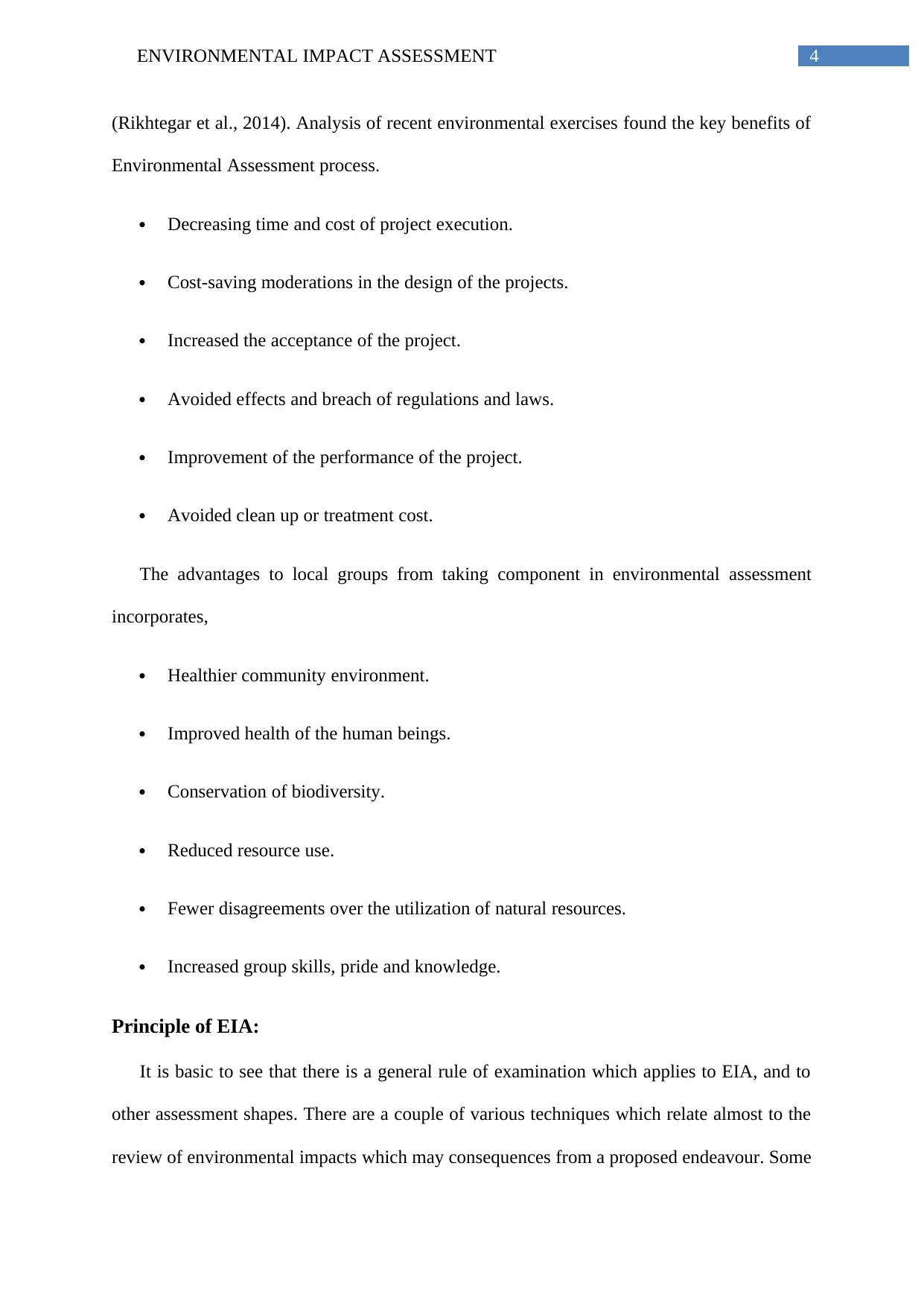
4ENVIRONMENTAL IMPACT ASSESSMENT
(Rikhtegar et al., 2014). Analysis of recent environmental exercises found the key benefits of
Environmental Assessment process.
Decreasing time and cost of project execution.
Cost-saving moderations in the design of the projects.
Increased the acceptance of the project.
Avoided effects and breach of regulations and laws.
Improvement of the performance of the project.
Avoided clean up or treatment cost.
The advantages to local groups from taking component in environmental assessment
incorporates,
Healthier community environment.
Improved health of the human beings.
Conservation of biodiversity.
Reduced resource use.
Fewer disagreements over the utilization of natural resources.
Increased group skills, pride and knowledge.
Principle of EIA:
It is basic to see that there is a general rule of examination which applies to EIA, and to
other assessment shapes. There are a couple of various techniques which relate almost to the
review of environmental impacts which may consequences from a proposed endeavour. Some
(Rikhtegar et al., 2014). Analysis of recent environmental exercises found the key benefits of
Environmental Assessment process.
Decreasing time and cost of project execution.
Cost-saving moderations in the design of the projects.
Increased the acceptance of the project.
Avoided effects and breach of regulations and laws.
Improvement of the performance of the project.
Avoided clean up or treatment cost.
The advantages to local groups from taking component in environmental assessment
incorporates,
Healthier community environment.
Improved health of the human beings.
Conservation of biodiversity.
Reduced resource use.
Fewer disagreements over the utilization of natural resources.
Increased group skills, pride and knowledge.
Principle of EIA:
It is basic to see that there is a general rule of examination which applies to EIA, and to
other assessment shapes. There are a couple of various techniques which relate almost to the
review of environmental impacts which may consequences from a proposed endeavour. Some
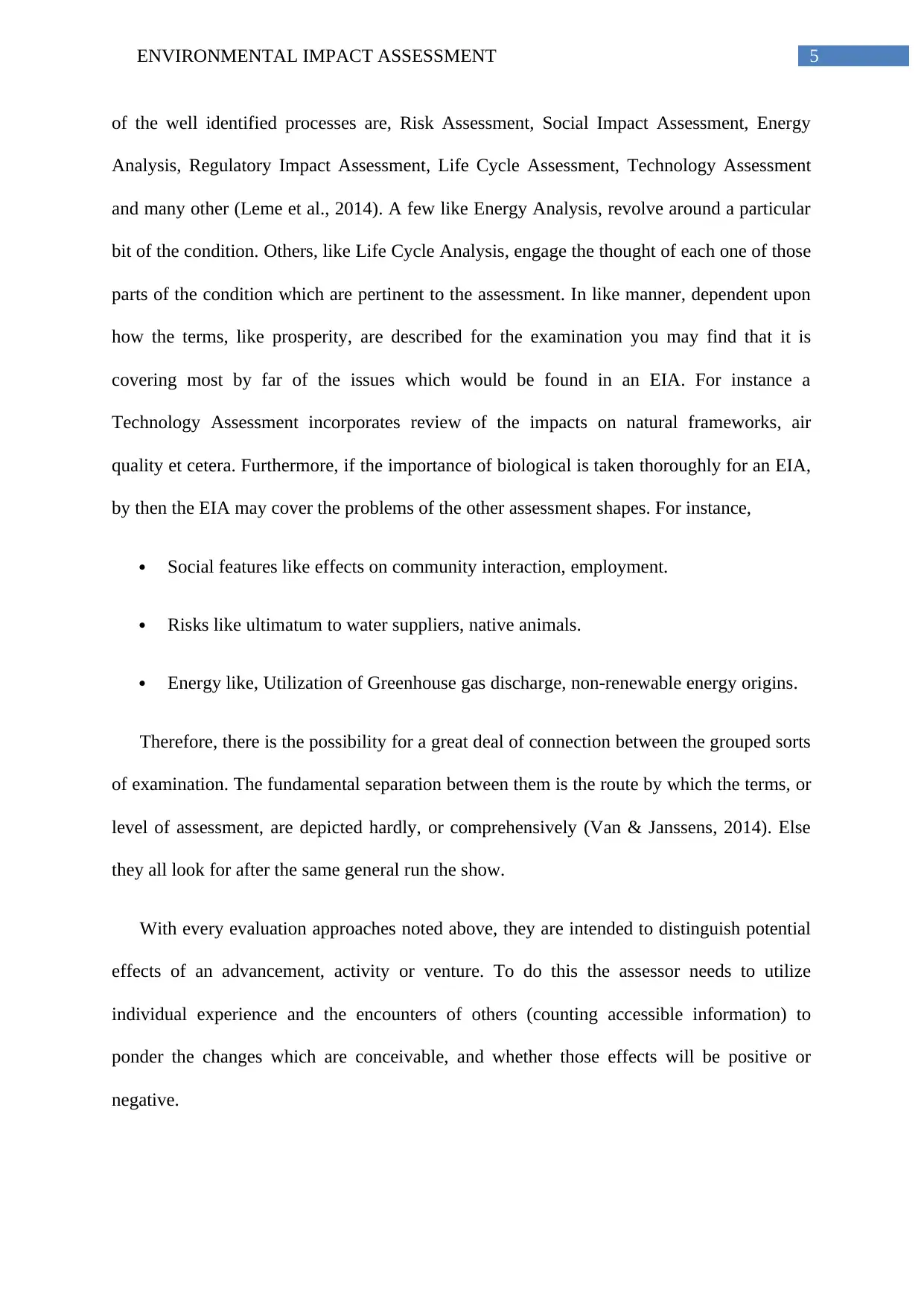
5ENVIRONMENTAL IMPACT ASSESSMENT
of the well identified processes are, Risk Assessment, Social Impact Assessment, Energy
Analysis, Regulatory Impact Assessment, Life Cycle Assessment, Technology Assessment
and many other (Leme et al., 2014). A few like Energy Analysis, revolve around a particular
bit of the condition. Others, like Life Cycle Analysis, engage the thought of each one of those
parts of the condition which are pertinent to the assessment. In like manner, dependent upon
how the terms, like prosperity, are described for the examination you may find that it is
covering most by far of the issues which would be found in an EIA. For instance a
Technology Assessment incorporates review of the impacts on natural frameworks, air
quality et cetera. Furthermore, if the importance of biological is taken thoroughly for an EIA,
by then the EIA may cover the problems of the other assessment shapes. For instance,
Social features like effects on community interaction, employment.
Risks like ultimatum to water suppliers, native animals.
Energy like, Utilization of Greenhouse gas discharge, non-renewable energy origins.
Therefore, there is the possibility for a great deal of connection between the grouped sorts
of examination. The fundamental separation between them is the route by which the terms, or
level of assessment, are depicted hardly, or comprehensively (Van & Janssens, 2014). Else
they all look for after the same general run the show.
With every evaluation approaches noted above, they are intended to distinguish potential
effects of an advancement, activity or venture. To do this the assessor needs to utilize
individual experience and the encounters of others (counting accessible information) to
ponder the changes which are conceivable, and whether those effects will be positive or
negative.
of the well identified processes are, Risk Assessment, Social Impact Assessment, Energy
Analysis, Regulatory Impact Assessment, Life Cycle Assessment, Technology Assessment
and many other (Leme et al., 2014). A few like Energy Analysis, revolve around a particular
bit of the condition. Others, like Life Cycle Analysis, engage the thought of each one of those
parts of the condition which are pertinent to the assessment. In like manner, dependent upon
how the terms, like prosperity, are described for the examination you may find that it is
covering most by far of the issues which would be found in an EIA. For instance a
Technology Assessment incorporates review of the impacts on natural frameworks, air
quality et cetera. Furthermore, if the importance of biological is taken thoroughly for an EIA,
by then the EIA may cover the problems of the other assessment shapes. For instance,
Social features like effects on community interaction, employment.
Risks like ultimatum to water suppliers, native animals.
Energy like, Utilization of Greenhouse gas discharge, non-renewable energy origins.
Therefore, there is the possibility for a great deal of connection between the grouped sorts
of examination. The fundamental separation between them is the route by which the terms, or
level of assessment, are depicted hardly, or comprehensively (Van & Janssens, 2014). Else
they all look for after the same general run the show.
With every evaluation approaches noted above, they are intended to distinguish potential
effects of an advancement, activity or venture. To do this the assessor needs to utilize
individual experience and the encounters of others (counting accessible information) to
ponder the changes which are conceivable, and whether those effects will be positive or
negative.
⊘ This is a preview!⊘
Do you want full access?
Subscribe today to unlock all pages.

Trusted by 1+ million students worldwide
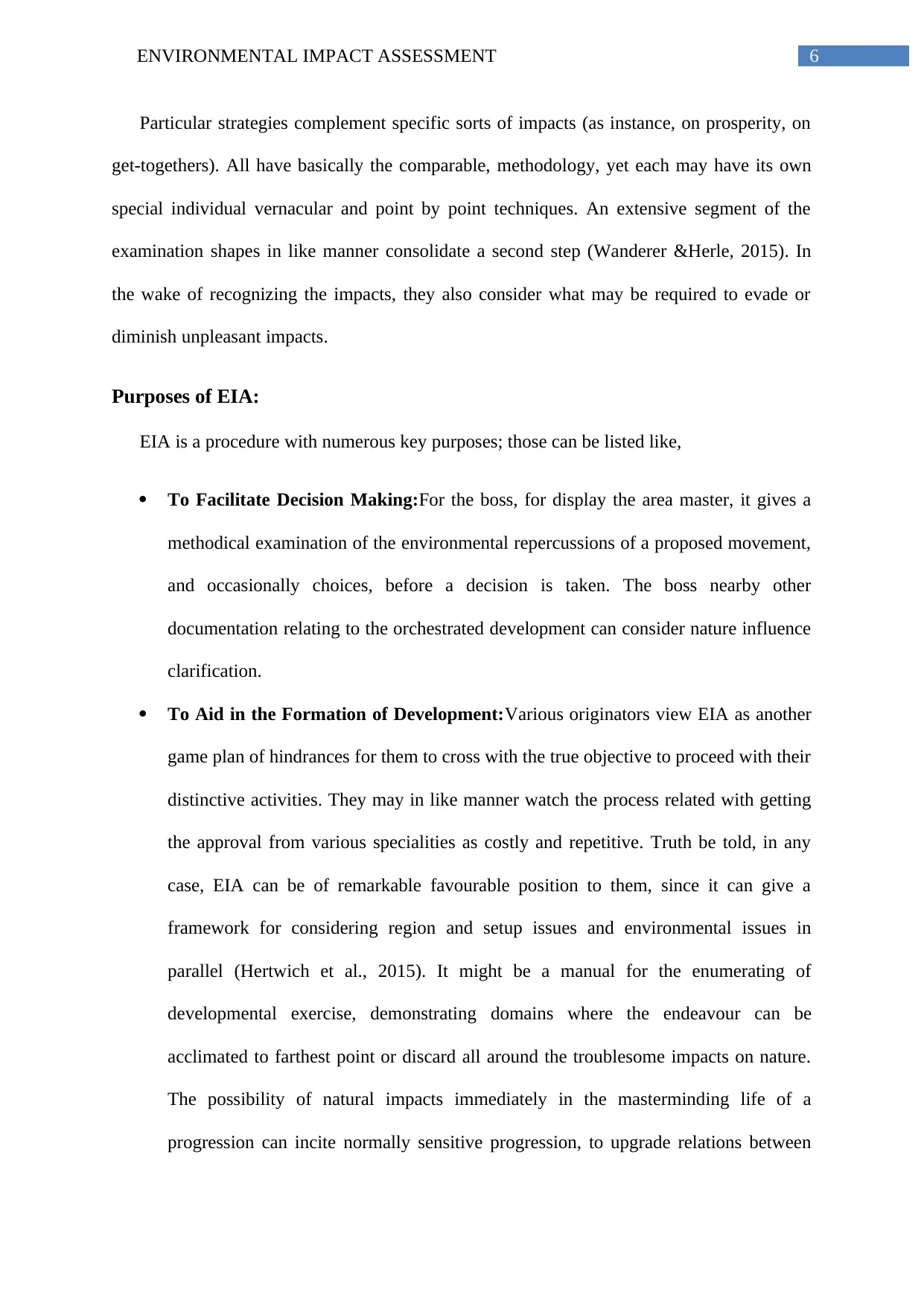
6ENVIRONMENTAL IMPACT ASSESSMENT
Particular strategies complement specific sorts of impacts (as instance, on prosperity, on
get-togethers). All have basically the comparable, methodology, yet each may have its own
special individual vernacular and point by point techniques. An extensive segment of the
examination shapes in like manner consolidate a second step (Wanderer &Herle, 2015). In
the wake of recognizing the impacts, they also consider what may be required to evade or
diminish unpleasant impacts.
Purposes of EIA:
EIA is a procedure with numerous key purposes; those can be listed like,
To Facilitate Decision Making:For the boss, for display the area master, it gives a
methodical examination of the environmental repercussions of a proposed movement,
and occasionally choices, before a decision is taken. The boss nearby other
documentation relating to the orchestrated development can consider nature influence
clarification.
To Aid in the Formation of Development:Various originators view EIA as another
game plan of hindrances for them to cross with the true objective to proceed with their
distinctive activities. They may in like manner watch the process related with getting
the approval from various specialities as costly and repetitive. Truth be told, in any
case, EIA can be of remarkable favourable position to them, since it can give a
framework for considering region and setup issues and environmental issues in
parallel (Hertwich et al., 2015). It might be a manual for the enumerating of
developmental exercise, demonstrating domains where the endeavour can be
acclimated to farthest point or discard all around the troublesome impacts on nature.
The possibility of natural impacts immediately in the masterminding life of a
progression can incite normally sensitive progression, to upgrade relations between
Particular strategies complement specific sorts of impacts (as instance, on prosperity, on
get-togethers). All have basically the comparable, methodology, yet each may have its own
special individual vernacular and point by point techniques. An extensive segment of the
examination shapes in like manner consolidate a second step (Wanderer &Herle, 2015). In
the wake of recognizing the impacts, they also consider what may be required to evade or
diminish unpleasant impacts.
Purposes of EIA:
EIA is a procedure with numerous key purposes; those can be listed like,
To Facilitate Decision Making:For the boss, for display the area master, it gives a
methodical examination of the environmental repercussions of a proposed movement,
and occasionally choices, before a decision is taken. The boss nearby other
documentation relating to the orchestrated development can consider nature influence
clarification.
To Aid in the Formation of Development:Various originators view EIA as another
game plan of hindrances for them to cross with the true objective to proceed with their
distinctive activities. They may in like manner watch the process related with getting
the approval from various specialities as costly and repetitive. Truth be told, in any
case, EIA can be of remarkable favourable position to them, since it can give a
framework for considering region and setup issues and environmental issues in
parallel (Hertwich et al., 2015). It might be a manual for the enumerating of
developmental exercise, demonstrating domains where the endeavour can be
acclimated to farthest point or discard all around the troublesome impacts on nature.
The possibility of natural impacts immediately in the masterminding life of a
progression can incite normally sensitive progression, to upgrade relations between
Paraphrase This Document
Need a fresh take? Get an instant paraphrase of this document with our AI Paraphraser
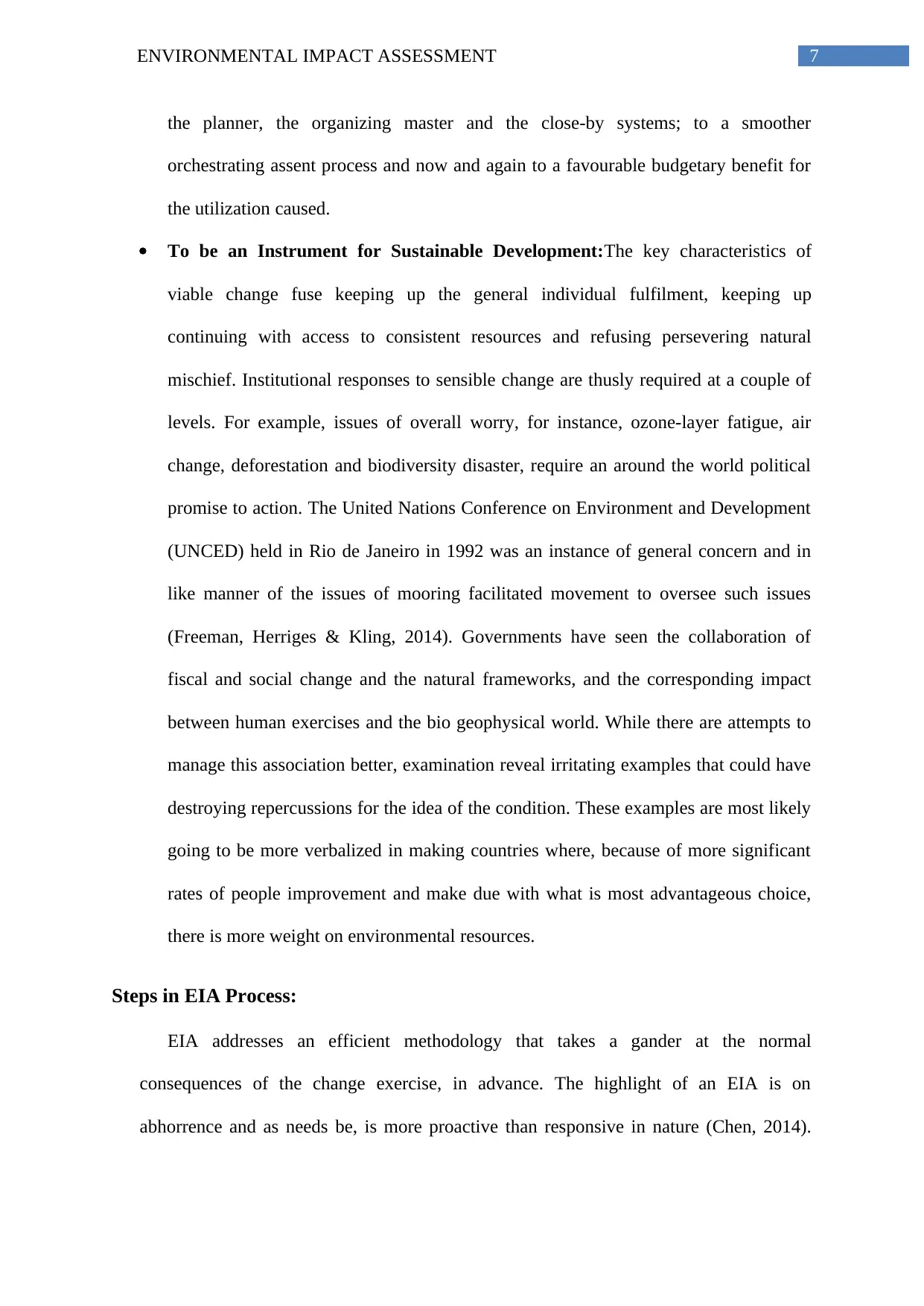
7ENVIRONMENTAL IMPACT ASSESSMENT
the planner, the organizing master and the close-by systems; to a smoother
orchestrating assent process and now and again to a favourable budgetary benefit for
the utilization caused.
To be an Instrument for Sustainable Development:The key characteristics of
viable change fuse keeping up the general individual fulfilment, keeping up
continuing with access to consistent resources and refusing persevering natural
mischief. Institutional responses to sensible change are thusly required at a couple of
levels. For example, issues of overall worry, for instance, ozone-layer fatigue, air
change, deforestation and biodiversity disaster, require an around the world political
promise to action. The United Nations Conference on Environment and Development
(UNCED) held in Rio de Janeiro in 1992 was an instance of general concern and in
like manner of the issues of mooring facilitated movement to oversee such issues
(Freeman, Herriges & Kling, 2014). Governments have seen the collaboration of
fiscal and social change and the natural frameworks, and the corresponding impact
between human exercises and the bio geophysical world. While there are attempts to
manage this association better, examination reveal irritating examples that could have
destroying repercussions for the idea of the condition. These examples are most likely
going to be more verbalized in making countries where, because of more significant
rates of people improvement and make due with what is most advantageous choice,
there is more weight on environmental resources.
Steps in EIA Process:
EIA addresses an efficient methodology that takes a gander at the normal
consequences of the change exercise, in advance. The highlight of an EIA is on
abhorrence and as needs be, is more proactive than responsive in nature (Chen, 2014).
the planner, the organizing master and the close-by systems; to a smoother
orchestrating assent process and now and again to a favourable budgetary benefit for
the utilization caused.
To be an Instrument for Sustainable Development:The key characteristics of
viable change fuse keeping up the general individual fulfilment, keeping up
continuing with access to consistent resources and refusing persevering natural
mischief. Institutional responses to sensible change are thusly required at a couple of
levels. For example, issues of overall worry, for instance, ozone-layer fatigue, air
change, deforestation and biodiversity disaster, require an around the world political
promise to action. The United Nations Conference on Environment and Development
(UNCED) held in Rio de Janeiro in 1992 was an instance of general concern and in
like manner of the issues of mooring facilitated movement to oversee such issues
(Freeman, Herriges & Kling, 2014). Governments have seen the collaboration of
fiscal and social change and the natural frameworks, and the corresponding impact
between human exercises and the bio geophysical world. While there are attempts to
manage this association better, examination reveal irritating examples that could have
destroying repercussions for the idea of the condition. These examples are most likely
going to be more verbalized in making countries where, because of more significant
rates of people improvement and make due with what is most advantageous choice,
there is more weight on environmental resources.
Steps in EIA Process:
EIA addresses an efficient methodology that takes a gander at the normal
consequences of the change exercise, in advance. The highlight of an EIA is on
abhorrence and as needs be, is more proactive than responsive in nature (Chen, 2014).
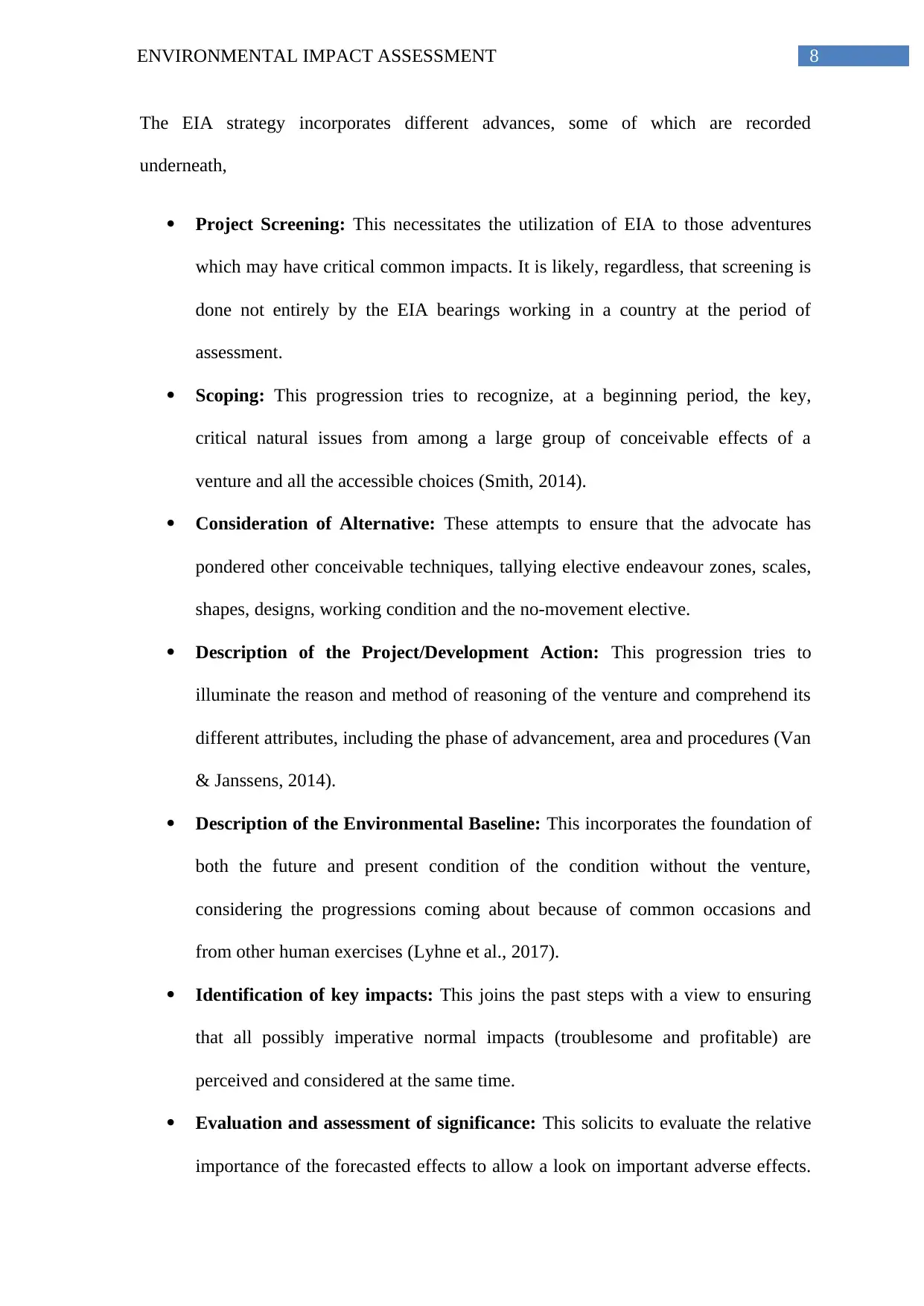
8ENVIRONMENTAL IMPACT ASSESSMENT
The EIA strategy incorporates different advances, some of which are recorded
underneath,
Project Screening: This necessitates the utilization of EIA to those adventures
which may have critical common impacts. It is likely, regardless, that screening is
done not entirely by the EIA bearings working in a country at the period of
assessment.
Scoping: This progression tries to recognize, at a beginning period, the key,
critical natural issues from among a large group of conceivable effects of a
venture and all the accessible choices (Smith, 2014).
Consideration of Alternative: These attempts to ensure that the advocate has
pondered other conceivable techniques, tallying elective endeavour zones, scales,
shapes, designs, working condition and the no-movement elective.
Description of the Project/Development Action: This progression tries to
illuminate the reason and method of reasoning of the venture and comprehend its
different attributes, including the phase of advancement, area and procedures (Van
& Janssens, 2014).
Description of the Environmental Baseline: This incorporates the foundation of
both the future and present condition of the condition without the venture,
considering the progressions coming about because of common occasions and
from other human exercises (Lyhne et al., 2017).
Identification of key impacts: This joins the past steps with a view to ensuring
that all possibly imperative normal impacts (troublesome and profitable) are
perceived and considered at the same time.
Evaluation and assessment of significance: This solicits to evaluate the relative
importance of the forecasted effects to allow a look on important adverse effects.
The EIA strategy incorporates different advances, some of which are recorded
underneath,
Project Screening: This necessitates the utilization of EIA to those adventures
which may have critical common impacts. It is likely, regardless, that screening is
done not entirely by the EIA bearings working in a country at the period of
assessment.
Scoping: This progression tries to recognize, at a beginning period, the key,
critical natural issues from among a large group of conceivable effects of a
venture and all the accessible choices (Smith, 2014).
Consideration of Alternative: These attempts to ensure that the advocate has
pondered other conceivable techniques, tallying elective endeavour zones, scales,
shapes, designs, working condition and the no-movement elective.
Description of the Project/Development Action: This progression tries to
illuminate the reason and method of reasoning of the venture and comprehend its
different attributes, including the phase of advancement, area and procedures (Van
& Janssens, 2014).
Description of the Environmental Baseline: This incorporates the foundation of
both the future and present condition of the condition without the venture,
considering the progressions coming about because of common occasions and
from other human exercises (Lyhne et al., 2017).
Identification of key impacts: This joins the past steps with a view to ensuring
that all possibly imperative normal impacts (troublesome and profitable) are
perceived and considered at the same time.
Evaluation and assessment of significance: This solicits to evaluate the relative
importance of the forecasted effects to allow a look on important adverse effects.
⊘ This is a preview!⊘
Do you want full access?
Subscribe today to unlock all pages.

Trusted by 1+ million students worldwide
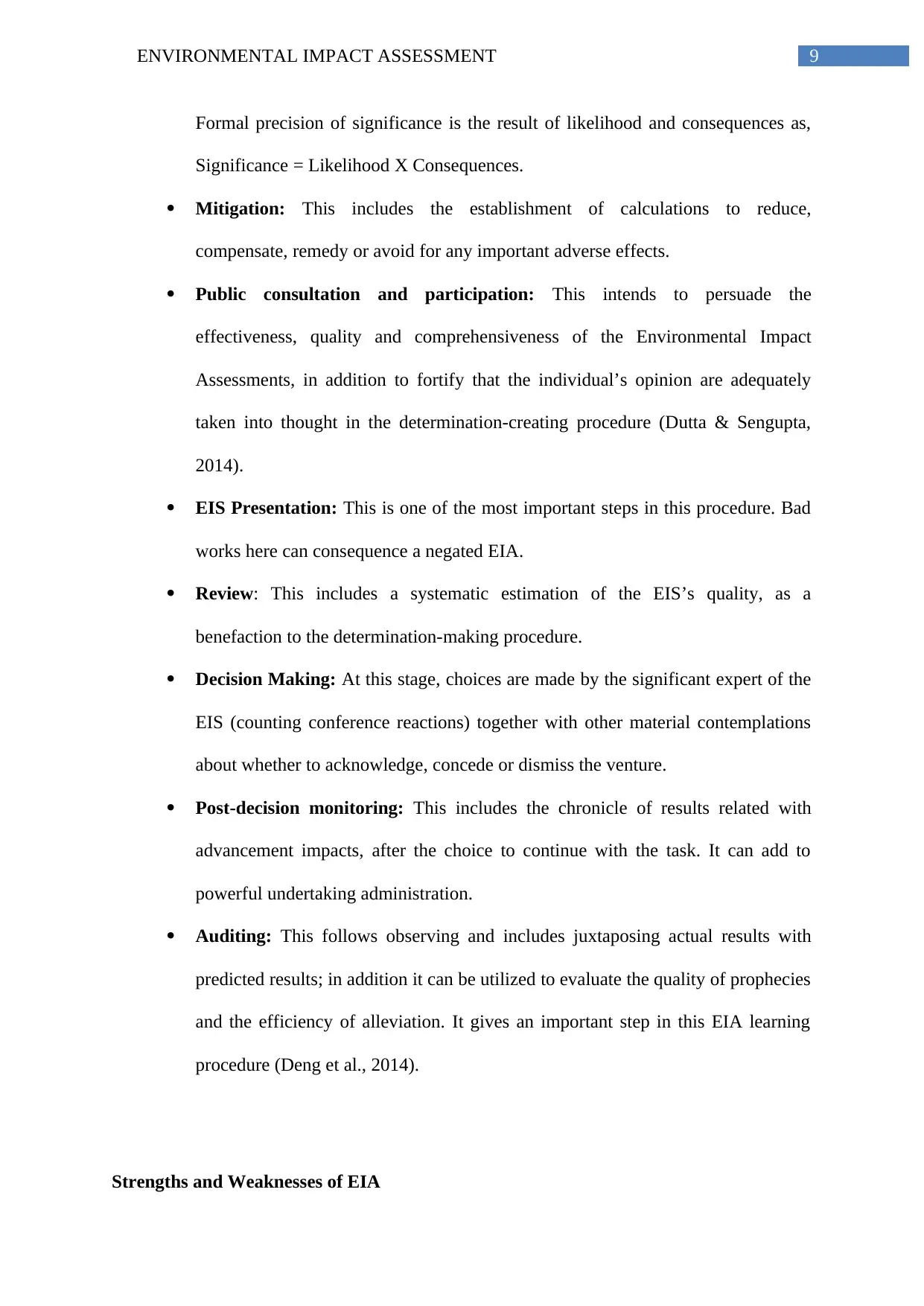
9ENVIRONMENTAL IMPACT ASSESSMENT
Formal precision of significance is the result of likelihood and consequences as,
Significance = Likelihood X Consequences.
Mitigation: This includes the establishment of calculations to reduce,
compensate, remedy or avoid for any important adverse effects.
Public consultation and participation: This intends to persuade the
effectiveness, quality and comprehensiveness of the Environmental Impact
Assessments, in addition to fortify that the individual’s opinion are adequately
taken into thought in the determination-creating procedure (Dutta & Sengupta,
2014).
EIS Presentation: This is one of the most important steps in this procedure. Bad
works here can consequence a negated EIA.
Review: This includes a systematic estimation of the EIS’s quality, as a
benefaction to the determination-making procedure.
Decision Making: At this stage, choices are made by the significant expert of the
EIS (counting conference reactions) together with other material contemplations
about whether to acknowledge, concede or dismiss the venture.
Post-decision monitoring: This includes the chronicle of results related with
advancement impacts, after the choice to continue with the task. It can add to
powerful undertaking administration.
Auditing: This follows observing and includes juxtaposing actual results with
predicted results; in addition it can be utilized to evaluate the quality of prophecies
and the efficiency of alleviation. It gives an important step in this EIA learning
procedure (Deng et al., 2014).
Strengths and Weaknesses of EIA
Formal precision of significance is the result of likelihood and consequences as,
Significance = Likelihood X Consequences.
Mitigation: This includes the establishment of calculations to reduce,
compensate, remedy or avoid for any important adverse effects.
Public consultation and participation: This intends to persuade the
effectiveness, quality and comprehensiveness of the Environmental Impact
Assessments, in addition to fortify that the individual’s opinion are adequately
taken into thought in the determination-creating procedure (Dutta & Sengupta,
2014).
EIS Presentation: This is one of the most important steps in this procedure. Bad
works here can consequence a negated EIA.
Review: This includes a systematic estimation of the EIS’s quality, as a
benefaction to the determination-making procedure.
Decision Making: At this stage, choices are made by the significant expert of the
EIS (counting conference reactions) together with other material contemplations
about whether to acknowledge, concede or dismiss the venture.
Post-decision monitoring: This includes the chronicle of results related with
advancement impacts, after the choice to continue with the task. It can add to
powerful undertaking administration.
Auditing: This follows observing and includes juxtaposing actual results with
predicted results; in addition it can be utilized to evaluate the quality of prophecies
and the efficiency of alleviation. It gives an important step in this EIA learning
procedure (Deng et al., 2014).
Strengths and Weaknesses of EIA
Paraphrase This Document
Need a fresh take? Get an instant paraphrase of this document with our AI Paraphraser
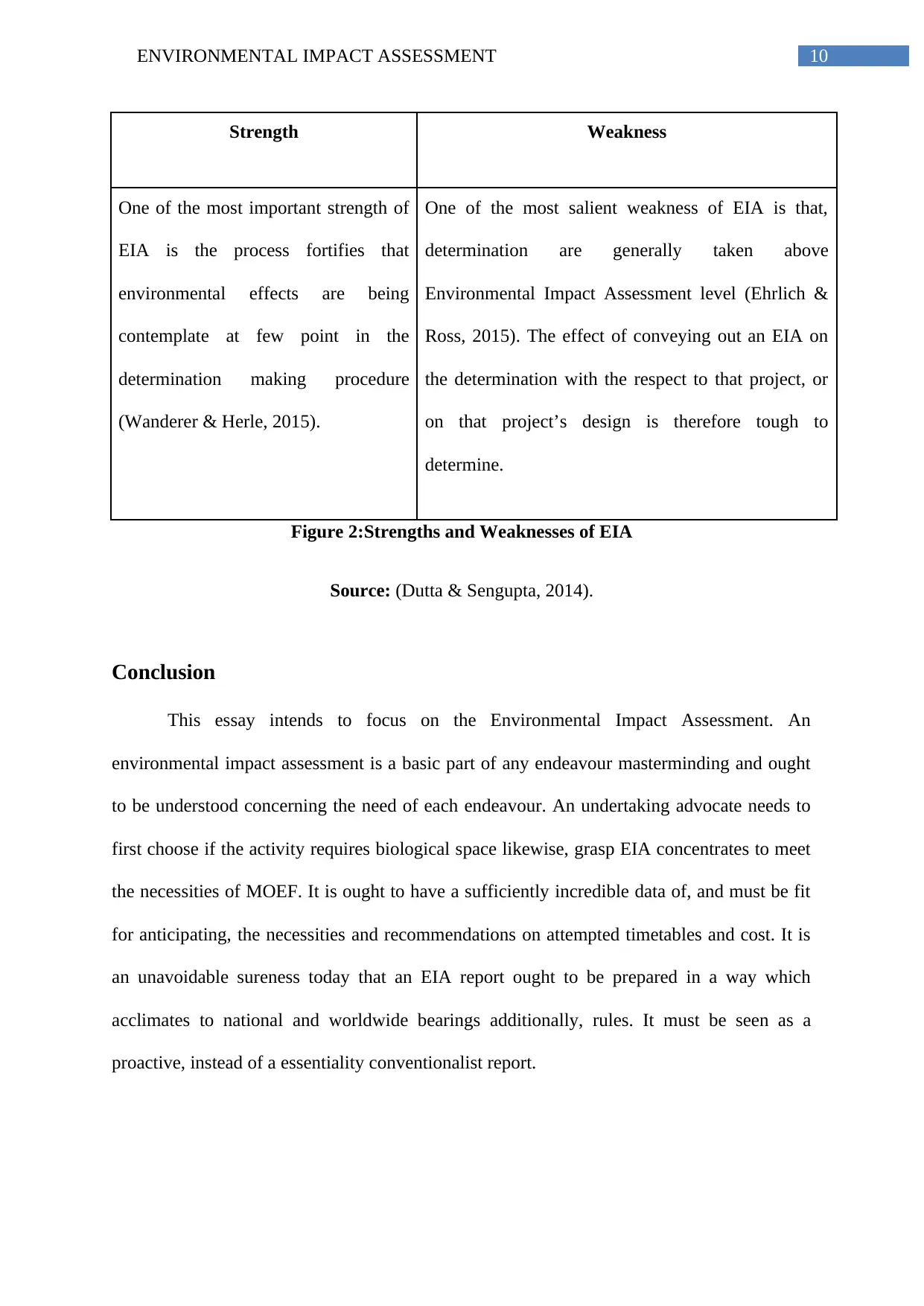
10ENVIRONMENTAL IMPACT ASSESSMENT
Strength Weakness
One of the most important strength of
EIA is the process fortifies that
environmental effects are being
contemplate at few point in the
determination making procedure
(Wanderer & Herle, 2015).
One of the most salient weakness of EIA is that,
determination are generally taken above
Environmental Impact Assessment level (Ehrlich &
Ross, 2015). The effect of conveying out an EIA on
the determination with the respect to that project, or
on that project’s design is therefore tough to
determine.
Figure 2:Strengths and Weaknesses of EIA
Source: (Dutta & Sengupta, 2014).
Conclusion
This essay intends to focus on the Environmental Impact Assessment. An
environmental impact assessment is a basic part of any endeavour masterminding and ought
to be understood concerning the need of each endeavour. An undertaking advocate needs to
first choose if the activity requires biological space likewise, grasp EIA concentrates to meet
the necessities of MOEF. It is ought to have a sufficiently incredible data of, and must be fit
for anticipating, the necessities and recommendations on attempted timetables and cost. It is
an unavoidable sureness today that an EIA report ought to be prepared in a way which
acclimates to national and worldwide bearings additionally, rules. It must be seen as a
proactive, instead of a essentiality conventionalist report.
Strength Weakness
One of the most important strength of
EIA is the process fortifies that
environmental effects are being
contemplate at few point in the
determination making procedure
(Wanderer & Herle, 2015).
One of the most salient weakness of EIA is that,
determination are generally taken above
Environmental Impact Assessment level (Ehrlich &
Ross, 2015). The effect of conveying out an EIA on
the determination with the respect to that project, or
on that project’s design is therefore tough to
determine.
Figure 2:Strengths and Weaknesses of EIA
Source: (Dutta & Sengupta, 2014).
Conclusion
This essay intends to focus on the Environmental Impact Assessment. An
environmental impact assessment is a basic part of any endeavour masterminding and ought
to be understood concerning the need of each endeavour. An undertaking advocate needs to
first choose if the activity requires biological space likewise, grasp EIA concentrates to meet
the necessities of MOEF. It is ought to have a sufficiently incredible data of, and must be fit
for anticipating, the necessities and recommendations on attempted timetables and cost. It is
an unavoidable sureness today that an EIA report ought to be prepared in a way which
acclimates to national and worldwide bearings additionally, rules. It must be seen as a
proactive, instead of a essentiality conventionalist report.
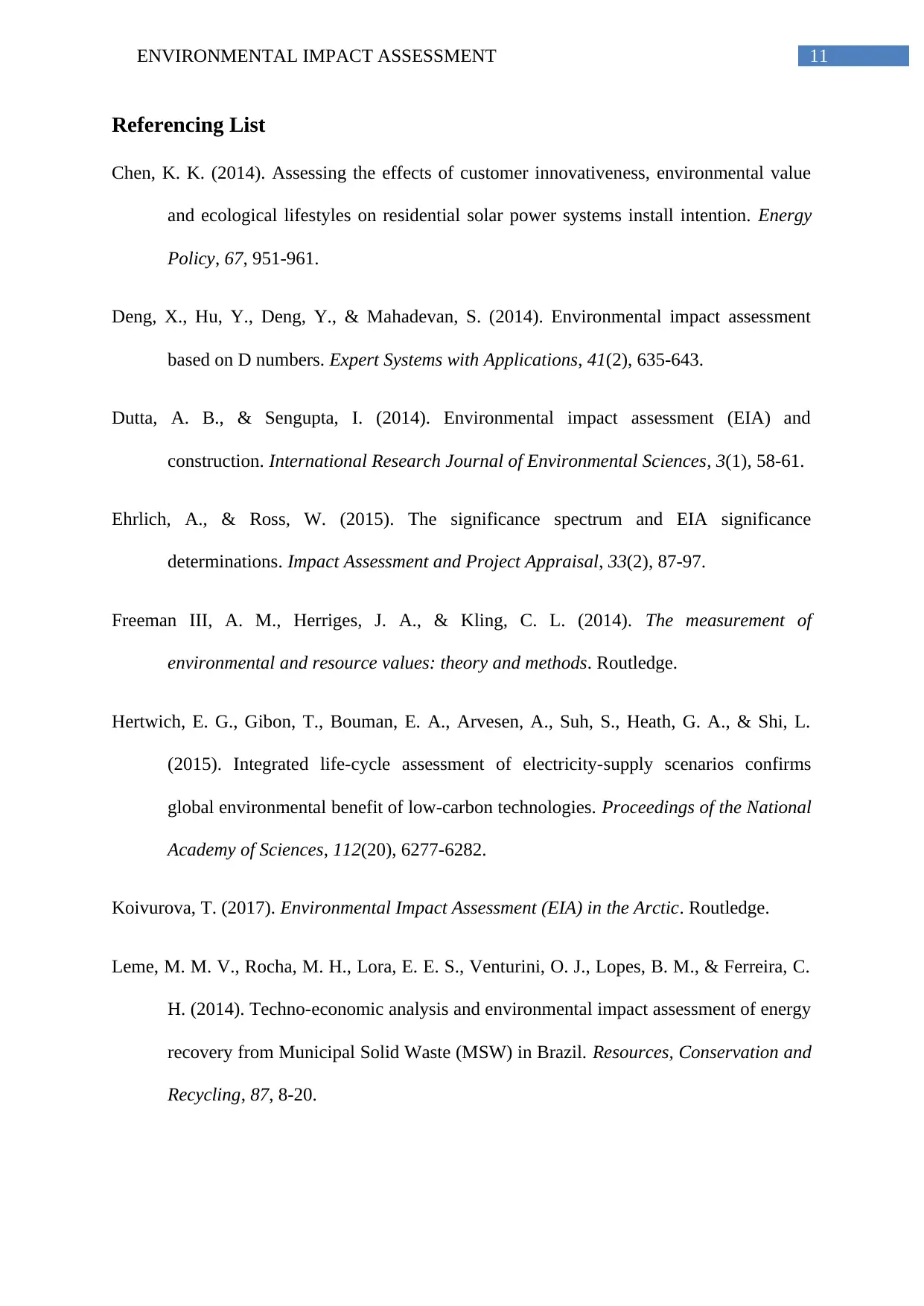
11ENVIRONMENTAL IMPACT ASSESSMENT
Referencing List
Chen, K. K. (2014). Assessing the effects of customer innovativeness, environmental value
and ecological lifestyles on residential solar power systems install intention. Energy
Policy, 67, 951-961.
Deng, X., Hu, Y., Deng, Y., & Mahadevan, S. (2014). Environmental impact assessment
based on D numbers. Expert Systems with Applications, 41(2), 635-643.
Dutta, A. B., & Sengupta, I. (2014). Environmental impact assessment (EIA) and
construction. International Research Journal of Environmental Sciences, 3(1), 58-61.
Ehrlich, A., & Ross, W. (2015). The significance spectrum and EIA significance
determinations. Impact Assessment and Project Appraisal, 33(2), 87-97.
Freeman III, A. M., Herriges, J. A., & Kling, C. L. (2014). The measurement of
environmental and resource values: theory and methods. Routledge.
Hertwich, E. G., Gibon, T., Bouman, E. A., Arvesen, A., Suh, S., Heath, G. A., & Shi, L.
(2015). Integrated life-cycle assessment of electricity-supply scenarios confirms
global environmental benefit of low-carbon technologies. Proceedings of the National
Academy of Sciences, 112(20), 6277-6282.
Koivurova, T. (2017). Environmental Impact Assessment (EIA) in the Arctic. Routledge.
Leme, M. M. V., Rocha, M. H., Lora, E. E. S., Venturini, O. J., Lopes, B. M., & Ferreira, C.
H. (2014). Techno-economic analysis and environmental impact assessment of energy
recovery from Municipal Solid Waste (MSW) in Brazil. Resources, Conservation and
Recycling, 87, 8-20.
Referencing List
Chen, K. K. (2014). Assessing the effects of customer innovativeness, environmental value
and ecological lifestyles on residential solar power systems install intention. Energy
Policy, 67, 951-961.
Deng, X., Hu, Y., Deng, Y., & Mahadevan, S. (2014). Environmental impact assessment
based on D numbers. Expert Systems with Applications, 41(2), 635-643.
Dutta, A. B., & Sengupta, I. (2014). Environmental impact assessment (EIA) and
construction. International Research Journal of Environmental Sciences, 3(1), 58-61.
Ehrlich, A., & Ross, W. (2015). The significance spectrum and EIA significance
determinations. Impact Assessment and Project Appraisal, 33(2), 87-97.
Freeman III, A. M., Herriges, J. A., & Kling, C. L. (2014). The measurement of
environmental and resource values: theory and methods. Routledge.
Hertwich, E. G., Gibon, T., Bouman, E. A., Arvesen, A., Suh, S., Heath, G. A., & Shi, L.
(2015). Integrated life-cycle assessment of electricity-supply scenarios confirms
global environmental benefit of low-carbon technologies. Proceedings of the National
Academy of Sciences, 112(20), 6277-6282.
Koivurova, T. (2017). Environmental Impact Assessment (EIA) in the Arctic. Routledge.
Leme, M. M. V., Rocha, M. H., Lora, E. E. S., Venturini, O. J., Lopes, B. M., & Ferreira, C.
H. (2014). Techno-economic analysis and environmental impact assessment of energy
recovery from Municipal Solid Waste (MSW) in Brazil. Resources, Conservation and
Recycling, 87, 8-20.
⊘ This is a preview!⊘
Do you want full access?
Subscribe today to unlock all pages.

Trusted by 1+ million students worldwide
1 out of 14
Related Documents
Your All-in-One AI-Powered Toolkit for Academic Success.
+13062052269
info@desklib.com
Available 24*7 on WhatsApp / Email
![[object Object]](/_next/static/media/star-bottom.7253800d.svg)
Unlock your academic potential
Copyright © 2020–2025 A2Z Services. All Rights Reserved. Developed and managed by ZUCOL.




